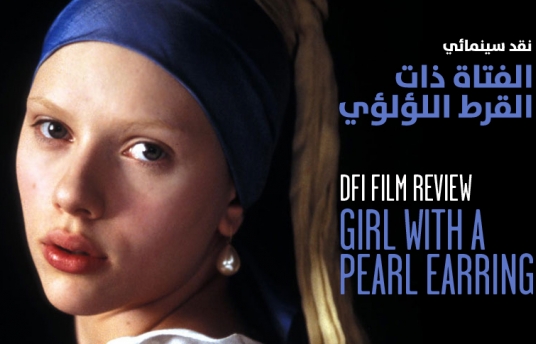DFI Film Review: Girl With A Pearl Earring (2003)
Jun 07, 2011

Written by Reem Shaddad, New Media, DFI
Film: Girl with a Pearl Earring
Year: 2003
Director: Peter Webber
Stars: Scarlett Johansson, Colin Firth, Tom Wilkinson
Genre: Biography, Drama, Romance
Peter Webber’s feature film debut, ‘Girl with a Pearl Earring’, tells the story of the exquisite 1665 Vermeer painting of the same name, which is also fondly known as the “Mona Lisa of the North”. The film is an adaptation of the historically inspired 1999 novel by Tracy Chevalier, also entitled ‘Girl with a Pearl Earring.’ With scores of BAFTA, Academy Award and Golden Globe nominations, the film made international waves upon its release in 2003, earning not only Director Peter Webber the recognition he deserved, but also his cast. Scarlett Johansson, who plays Griet, the 16 year old servant to the Vermeer household and the namesake of the title, was a fresh faced 19-year old at the time. Alongside ‘Lost in Translation’, ‘Girl with a Pearl Earring’ is touted as the film that put Johansson on the map for many in the film industry.
Starring alongside Hollywood heavyweights such as Colin Firth, Tom Wilkinson, Cillian Murphy and porcelain doll-like Australian beauty Essie Davis, the cast is impressive without the challenge of clashing overwhelming personalities. The scene is set in the Dutch Republic circa the 1660s, where the gap between the rich and the poor is glaringly evident. Griet (Scarlett Johansson), a young girl from a modest family, is sent to work in the tumultuous Vermeer household when her father, a Delftware painter, is rendered blind and therefore jobless by an unfortunate accident. Johannes Vermeer (Colin Firth) is viewed as both a talent and an eccentric soul, confined to painting commissions for his rich patron, Pieter Van Ruijven (Tom Wilkinson), but empty of the passion and inspiration required to produce more frequent pieces. This, of course, puts the Vermeer family into an almost ‘indebted’ situation with Van Ruijven, tending to his every artistic whim and pressuring Vermeer himself into an unpleasant niche.
Under the envious eye of Vermeer’s emotionally neglected wife, Catharina Bolnes Vermeer (Essie Davis), and the hawk-like demeanour of Vermeer’s mother-in-law, Maria Thins (played by the legendary Judy Parfitt), Griet is initially worked to the bone, serving the family day and night, even during Catharina’s childbirth. Through her daily tasks, which include trips to the market, Griet meets the butcher’s son Pieter (Murphy), who is instantly taken by her quick wit. Although flattered by Pieter’s boyish charms, Griet quickly becomes invested in the complex and tortured world of Vermeer’s art, unknowingly developing a connection with the master of the house. Vermeer is reciprocal, finally finding his muse in Griet. What ensues is a relationship that is both simple yet equally unacceptable in turn. Unfortunately, Griet’s endearing, almost childish demeanour and eagerness to please does not go unnoticed by either Maria Thins or Van Ruijven.
While Maria Thins secretly supports the growing bond between the house servant and her son-in-law – and only because of the sudden surge in production from Vermeer as a direct result – Van Ruijven’s interest is piqued in other ways. He takes a sickening liking to Griet, first forcing himself on her in the Vermeer household, and then requesting her transfer to serve in his home. Upon Vermeer’s adamant refusal, Van Ruijven instead commissions a painting of Griet – unbeknownst to the lady of the house, Catharina. The painting is, of course, ‘Girl with a Pearl Earring’, which features Griet with a glowing pearl dangling from her ear, pierced by Vermeer himself, and handed to her by Maria Thins herself. This action is born of desperation and greed rather than kindness, symbolising a loss of innocence and an acute sense of exploitation. Catharina soon, however, discovers her pearls are missing, and she is quick to blame the girl she finds herself competing for her husband’s affections with: Griet.
The intimacy created through the love of painting is one Catharina has never shared with Vermeer, and she feels like a stranger in her own home, with murmurings of deception from even her own mother. Griet is cast away from the Vermeer home, fuelled by feelings of jealousy, abandonment and the decadence of ignorance.
Confused at Vermeer’s lack of reaction to her departure, Griet is, in turn, the source of much troubled emotion in the Vermeer home as a whole, and even to Van Ruijven himself upon his receipt of the painting. The final gift of the blue headscarf she wore for the painting, along with Catharina’s pearl earrings, embody the emotional connect between Griet and Vermeer; a gesture that can be viewed as both gratuitous and dismissive in turn. A tale of power (Vermeer) over simplicity (Pieter); money (Van Riujven) over creativity (Vermeer); and a connection (Griet) over marital rights (Catharina), ‘Girl with a Pearl Earring’ remains relevant years after its release, and centuries after the painting itself was completed.
Girl With A Pearl Earring - Trailer
إعلان فيلم الفتاة ذات القرط اللؤلؤي